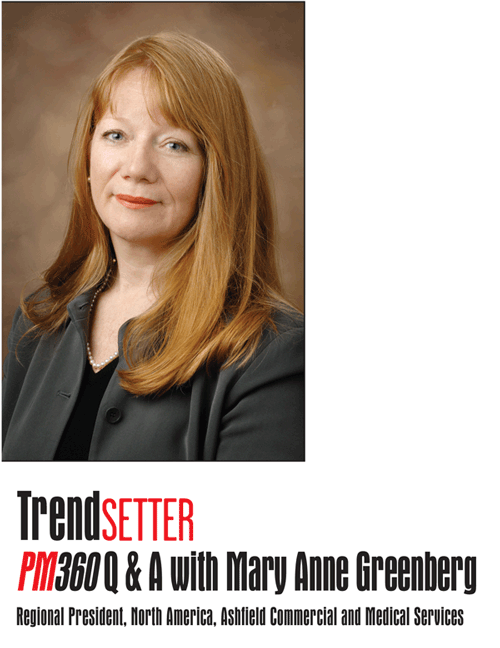Earlier this year, UDG Healthcare announced a new organizational structure that combines its sales, marketing and medical services under a single division called Ashfield Commercial and Medical Services. Mary Anne Greenberg leads the North American business, which includes eight areas of expertise. Among other things, she spoke with PM360 about why her company decided to make this change.
PM360: Can you explain the reasoning behind your company’s recent restructuring?
Mary Anne: Companies under the new Ashfield divisional umbrella have actually been working together to deliver services for a more than a year. Now was the time to formalize this arrangement for the industry. UDG, our parent company, strategically purchased the Ashfield companies, selecting them for their best-in-class services, their talent within the organization and their collaborative culture.
Recognizing that forcing people from disparate cultures to work together often leads to failure when attempting to bring companies together, we have built a culture in which people genuinely enjoy working together to design and implement innovative solutions for our clients. We’re very excited about the years ahead as our multiple disciplines work together to create a synergy that leads to much needed, ingenious solutions for pharma.
What are the advantages to having this synergy across multiple disciplines, especially considering some of those disciplines do not typically work together?
There are many advantages. Emerging companies commercializing their own drugs are looking for outsourced partners who won’t drain their already strapped internal resources. We are able to provide them with much of what they need with one point of contact on the medical side to manage our team to provide content, medical information, MSLs and pharmacovigilance and another expert and single point of contact for commercial teams. This is how companies are structured internally, so it makes doing business less complicated. Our point people are senior business unit directors who work closely within each business to tenaciously stay laser-focused on doing what it takes to make our clients successful and compliant.
Larger pharma companies are now changing the way they buy services—purchasing more services with fewer outsourced providers. Our global footprint is also attractive to pharma as they can purchase medical content and meeting logistics on a global level. We are finding increasing demand from procurement for global contracts resulting in local agreements in each of the 22 countries we serve.
The healthcare industry is obviously going through a lot of changes of its own via the ACA. How did these factors affect your company’s decision to make changes?
Our long history of doing business in the U.K. and across mainland Europe helps in understanding the challenges the industry now faces here. As a result, we can successfully meet the requirements of outcomes-based healthcare delivery with programs developed by our market communications companies, market access, field nurses and call centers to improve the quality of patient health, help educate and keep physicians more informed, as well as make drugs more accessible for patients.
What will it take for pharma companies and their vendors to be successful under this new healthcare system?
In short, pharma and its vendors need to be agile and flexible in these changing times. No longer is there one standard for all new and mature therapies. Vendors need to be able to deploy expert, customized services for short and medium terms, and flex in size and scope within a given project to deliver measurable results.
For instance, pharma companies can deploy sales teams seasonally or at launch to only those areas where formulary position has been achieved and use a call center to “warm” the states where formulary approval is further down the road. Personnel quality is also key along with the ability to attract top talent for all positions.
Many pharma companies face increasing difficulty reaching physicians. How do companies need to adjust their sales model to reach physicians today while also operating with a smaller sales force?
There is not one standard way. Promoted products can benefit greatly by using clinical educator teams who support healthcare professionals and patients in understanding when to use and how to initiate treatment. This approach brings clarity and builds confidence. In addition, communication methods can be matched, using the phone or digital media, with physician or patient preference.
The industry can no longer afford to silo services, but must integrate efforts to get optimum results. Although slow in coming, pharma now understands the value of data in unraveling physician behavior—and which communication vehicles have the desired impact. Pharma marketers need to understand the best time to call, which offices have PAs, which ones refuse to speak on the phone, which ones can be reached, which embrace in-office education, etc. This goes a long way in optimizing resources.
More physicians are now joining hospital systems, accountable care organizations (ACOs) or becoming part of integrated delivery networks (IDNs). So, how can pharma companies ensure they are reaching key decision-makers at these larger organizations?
It is critical to know the rules of engagement with the practice as physicians begin to behave more and more like employees. The key is bringing value. We need to give practices tools to help educate patients by rolling up patient data gathered in the field and on the phone. This data can then be presented back in aggregate to assist office staff with understanding how they can help improve patient outcomes and aid in better physician navigation of the payer system. We also need to factor in the growing impact of market access on how physicians practice medicine.
What about reaching patients? How are patient programs evolving and what can healthcare companies do to ensure patients are compliant?
Patient education and support programs must be highly customized to the population in order to be successful. Programs designed to work the same for everyone bring little value.
Companies can customize programs using disease experts to educate the teams that develop patient education programs. Solutions that improve patient adherence may often involve multiple tactics that strongly emphasize an understanding of the challenges faced by patients and healthcare providers—as well as measuring patient outcomes. For instance, nurses can visit patients’ homes and help train patients to administer biologics. Patients who choose not to have someone visit them can use call centers to “visit” with nurses remotely using easy-to-access technology such as online screen sharing. Today’s successful programs are those that segment patients and apply the solution that drives behavior to affect the best health outcome.
Finally, considering all of the changes happening in this industry, do you have any advice or a personal philosophy to help guide people through it?
There’s a Mark Twain quote taped to my computer monitor that sums up my personal philosophy: “Do the right thing. It will gratify some people and astonish the rest.” It has served me well in both my professional and personal life.







